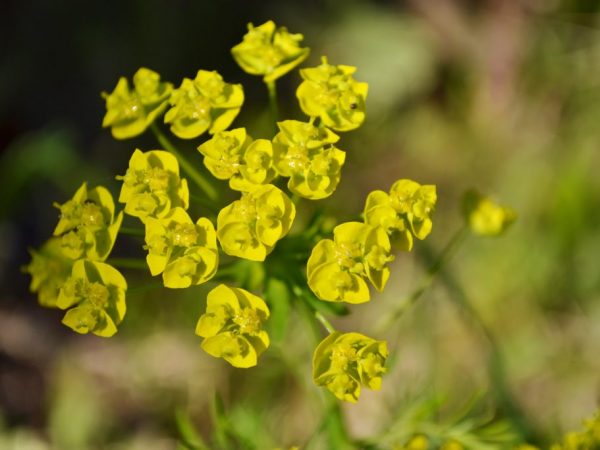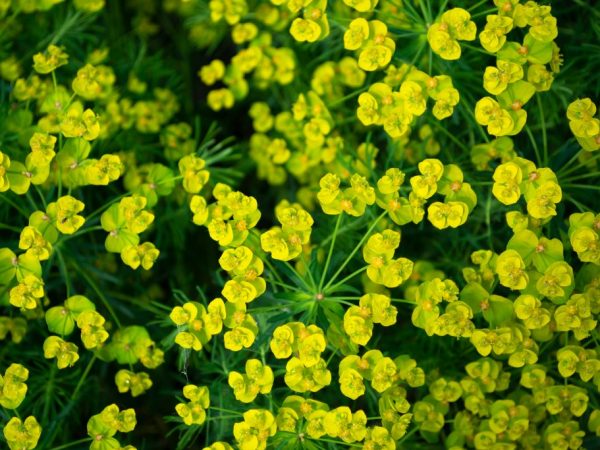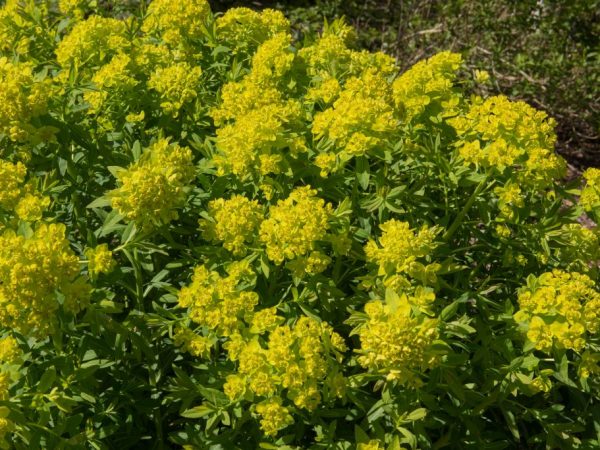Euphorbia Garden - care and methods of reproduction
The beautifully blooming garden spurge belongs to the Euphorbia family and is very popular in landscape design. The plant got this name due to the milky juice released when breaking or cutting. Consider what a decorative culture looks like and how to properly care for it.

Garden spurge
Description of the plant
The Latin name is euphorbia marginata. The homeland of growth is the island of Madagascar and the subtropics of the African continent.
A shrub perennial plant reaches a height of 70-80 cm, stems are thin, green, erect. Leaves are light green, oval, 5-6 cm long. At the top of each shoot, one inflorescence is formed with light green petals and yellow stipules. The root system is pivotal, goes deep into the ground, so drought is not terrible for euphorbia.
Varieties
Perennial garden milkweed has several decorative varieties that differ in color and size.
Myrtle-leaved. A compact shrub plant - about 25 cm high. The leaves are light green, geometric, small - 3-4 cm long, densely cover numerous stems. The shape of the bush is spherical and attractive in appearance.
It prefers to grow in a sunny location and in southern climates, therefore it is not suitable for growing in cold regions.
Capitate. The shrub received this name due to the spherical shape of yellowish and orange inflorescences. The bush consists of numerous thin shoots that reach a height of 10 cm.
The second name is official. The weed grows quickly, takes up a lot of space on the site, and therefore needs periodic thinning. The plant is unpretentious to the climate and soil, it can be grown in any region of our country.
Cypress. Medium-sized herbaceous shrub up to 40 cm high with sharp leaves resembling needles of needles. In the flowering phase, it takes on a spherical shape. It blooms twice a year - in late spring and in the last decade of August.
A plant with low frost resistance - withstands a drop down to -20 ° C.
Almond-shaped. The Latin name is purpurea. It differs from other varieties in bright light green flowers that attract attention and bewitch. Long bloom - from April to July. Height about 60 cm. The bush is densely branched, covered with small light green leaves.
Euphorbia is suitable for cultivation in the southern and temperate climates. Withstands light frosts - up to -15 ° С.
The prettiest, or red... Other names are poinsettia or Star of Bethlehem. Euphorbia blooms on the eve of Catholic Christmas.
Euphorbia is distinguished by decorative emerald-colored foliage and large reddish, pink or white inflorescences.Such a plant can be grown at home, providing diffused daylight, regular watering and feeding. Miniature bush - height 30-35 cm, so it does not take up much space on the windowsill.
Multi-flowered. The second name is bonfire. Tall shrub - up to 70 cm in length. In the flowering phase, the leaves acquire a rich light green hue, after a while they become lemon-colored.
Due to its good winter hardiness and frost resistance, multiflorous euphorbia is cultivated in all regions of Russia.
Bordered. Annual spurge with drop-shaped variegated green leaves with thick white stripes. Bracts and inflorescences are lacy, snow-white. Height varies from 50 to 70 cm.
Variegated. It got this name thanks to the leaves of different sizes - the lower ones are large, closer to the top they become smaller. Bracts with a red tint, give the bush a contrast against the background of emerald foliage.
Multi-colored. An annual plant with beautiful decorative foliage. Leaves of different lengths and colors are formed on one stem. Some are green, others with a reddish tint. In the flowering phase, the yellow bracts take on an orange tone.
Mediterranean. One of the most popular varieties among gardeners. The plant gained such popularity due to its attractive appearance - the stems and leaves acquire a bluish tint, which persists before and after flowering.
The leaf plate is oblong, 6-7 cm long. The height of the bush is about 1.5 m.
Griffith. The fire or red-leaved spurge, native to the Himalayas and China, has more than 2,000 species in the wild. The plant is large - it reaches 1 m in height. Leaves are dull green, towards autumn they acquire a yellowish tone. Bracts are bell-shaped, scarlet.
This colorful plant is one of the favorite among gardeners. It is readily used to decorate flower beds, flower beds, mixborders.
Stone-loving. It prefers to grow on rocky ground, therefore it is readily used in decorating alpine slides and rockeries. Shrub 50-80 cm high densely covered with small oval leaves of light green color with jagged edges.
Swamp. A multi-colored plant with reddish shoots, bright green foliage and yellow inflorescences. It grows well on waterlogged land, so it is often planted in lowlands, along the banks of water bodies.
Purchase and adaptation

We plant beautiful flowers
You can buy young bushes for transplanting to a garden plot at any gardening store. To get a strong and healthy plant that will grow in the future and become a real decoration of the garden, you should carefully examine it.
Determine high-quality specimens according to the following criteria:
- monophonic stems without cracks, breaks, yellow and black spots;
- leaves are whole, rich in color, juicy, when shaking off the crown they do not crumble;
- bracts and inflorescences are bright, without red, black blotches;
- through the drainage holes in the pot, you can determine the state of the root system - in healthy specimens, it is uniform dark brown without mold, acidification.
It is also important that the substrate is slightly damp and not moldy.
After purchase, the plant needs some time to adapt - they are transplanted only after 3 weeks. In 20 days you will understand whether he is sick with something or not.
If you bought a blooming euphorbia, you need to wait until it fades, because it is not advisable to transplant it during this period of life - it may not tolerate stress and will die.
Landing
This procedure is carried out in the spring, when the soil warms up to 10-12 ° C and the outside heat stabilizes.
The landing site is freed from garden debris and last year's vegetation. They dig in, add a deoxidizer if necessary, since this culture does not grow well in acidic soil.
The optimal acidity index is 6 units.Sprinkle the soil with dolomite flour, lime or chalk - 400 g is consumed per 1 m², dug up, leveled.
The site is prepared 2-3 weeks before disembarkation:
- They tear out holes according to the size of the root system, spill it with water, put a couple of handfuls of pebbles or dropouts on the bottom.
- Fill in half with a fertile mixture (the recipe is described above).
- They lower the roots, fill up all the voids with the remaining nutrient composition, crush them around the stem, water and sprinkle with garden soil to prevent rapid evaporation of moisture.
With a group landing, it is necessary to maintain a distance so that in the future there is no competition for space and moisture. The optimal layout in the open field is 50x70 cm.
Transfer
The procedure is carried out for purchased specimens, home shrubs - once every three years and plants whose root system has rotted or damaged by harmful insects and diseases.
The bush is watered abundantly, after an hour it is removed from the container or dug out with a garden shovel. Then it needs to be transplanted to the site by the method of transshipment of an earthen coma, so it will take root better and faster. For successful rooting and survival, it requires regular, but moderate watering, followed by mulching with humus.
For milkweed, which is grown in a pot, the transplant is carried out into a new flowerpot, 2-3 cm larger in diameter than the previous one. Take a container made of ceramic or plastic with drainage holes. Expanded clay or pebbles are laid at the bottom, the nutrient composition is added, the root system is lowered, covered with earth to the top, tamped, watered.
The necessary conditions

Grows well and requires little maintenance
The main care of this plant in the open field is not difficult and even a novice gardener can do it.
Site and soil selection
Garden spurge prefers to grow in a sunny or slightly shaded area, where the ground is loose and well-drained. Therefore, you should not plant it in a swampy area, the only exception is one variety - marsh. For everyone else, a place with groundwater bedding to a depth of 1.5 m is suitable.
The optimum composition of the soil is coarse-grained sand, garden soil, peat, brick chips and wood ash, mixed in a ratio of 1: 1: 1: 0.2: 0.2.
If you have purchased tall bushes, then when planting in this mixture, you can add 0.5 parts of compost or last year's manure.
Humidity
It prefers moderate humidity in the cold season, but during the growing season (spring and summer) it is recommended to periodically irrigate it with warm water.
This will have a positive effect on decorativeness, and will also help to avoid the appearance of parasites. The crown is sprayed in the evening hours once a week.
Temperature
Each variety requires a specific mode.
Some grow well in the southern zone, where the temperature can reach 20-30 ° C, others - perfectly take root in a harsh area with indicators of 15-19 ° C during the growing season.
Lighting
The plant loves to grow in an area with bright sunlight - it is not afraid of direct rays. Therefore, partial shade or shady place is not for him.
The optimal duration of a light day during the growing season is at least 10 hours. In autumn and winter, garden euphorbia safely tolerates a lack of lighting, because it enters a dormant stage.
Care
Watering
Street spurge during cultivation needs moderate but regular watering.
The soil is moistened only as the top layer of the earth dries out. In the rainy season, it is better to refuse the procedure, because excess moisture can provoke rotting of the root system and the death of the bush.
After moistening, it is worth loosing the soil to a depth of 3-4 cm in order to avoid injury to the roots. Loosening prevents crusting and provides good moisture and oxygen access to the roots.
Top dressing
The main care for euphorbia includes regular feeding, which increase immunity against diseases, frost resistance and decorative effect.
Nutrition for all species is the same - they use universal preparations for decorative flowering plants.
The dosage should be half as much as indicated on the package, because an excess of nutrients in the soil can lead to a decrease in the quality of flowering.
Fertilize according to the following scheme:
- in early spring, when leaves and new stems begin to develop;
- in the phase of active flowering - in July;
- in the first half of September until the moment of shelter.
Nutrition at the root is combined with watering to improve the quality of absorption of nutrients and prevent burning of the root system.
Pruning
Almost all types of garden milkweed form a beautiful and regular crown, so they do not need shaping. You can do a light haircut - remove twigs growing at an irregular angle or thickening the aerial part.
Some gardeners prune the bush so as to form an unusual crown out of it - in the form of a ball or a cube. Pruning is carried out gradually and annually so that the plant does not get severe stress and does not die.
Every spring, it is necessary to remove the stems that have frozen over the winter, as well as shriveled, broken off and disease-damaged shoots.
For sanitary pruning, a sterile and sharp pruner is used to prevent infection.
Preparing for winter
Almost all varieties of garden milkweed tolerate severe frosts well, so they do not need shelter.
A month before the onset of cold weather, a cardinal haircut is carried out - the shoots are completely cut off, leaving hemp 5-6 cm high, sprinkled with compost or humus.
For young specimens, after planting, shelter is necessary, since they have weak frost resistance. Sprinkle the near-trunk zone with fallen leaves. Heat-loving varieties should be covered with spruce branches, straw or sawdust. In order for the bushes to survive the winter safely, they stop watering at the end of summer.
Reproduction methods
There are several ways to propagate an ornamental shrub, each with advantages and disadvantages.
Cuttings
Shoots are cut during the flowering period. The branches from the top of the bush are cut off with a sharp and sterile object. The optimal length is 15-20 cm. The sections are washed under running water to wash off the remains of the milky juice. During this manipulation, it is necessary to wear rubber gloves to avoid contact of the poisonous substance on the skin of the hands.
The washed shoots are dried and the cut areas are treated with charcoal. They are planted in seedling boxes, plastic containers with a fertile composition or a mixture for decorative deciduous plants. The depth of planting of cuttings is 3-4 cm. After planting, they are watered, placed in a warm and well-lit place.
To speed up the rooting process, you can cover the seedlings with transparent film, ventilate and irrigate every day as needed. As soon as new leaves appear on the shoots, the shelter is removed, they continue to grow at home for another 3-4 weeks, then transplanted into open ground.
Seeds
The collected seeds are sown in a light and loose mixture of peat and sand (1: 1) in the fall. Sprinkle with water from a spray bottle, sprinkle with sawdust or humus on top to create a greenhouse effect.
Germination will take a long time - the first shoots should be expected in the spring. After mass emergence, seedlings are thinned out, yellowed shoots are removed. As soon as the seedlings get stronger, release one pair of leaves, they can be planted separately in a permanent habitat in the garden.
By dividing the bush
Usually this method is used when you need to rejuvenate an old bush. The division procedure is carried out in the spring. The plant is watered abundantly, removed from the soil, dipped in a container of water to wash off the remnants of the soil.
After that, they are dried, divided into several parts, so that each one has one shoot and 2-3 roots. Places of cuts are powdered with charcoal, seated separately. You can plant the delenki according to the above described technique and landing scheme.
Diseases and pests
Throughout the entire period of growth and development, this ornamental plant can be damaged by various parasites and infections.
| Diseases and pests | Symptoms | Treatment | Prophylaxis |
| Fusarium | Infection occurs through the soil. Stems and leaves darken at the bottom of the bush | Treat with Fitosporin, Previkur or Trichophyte | It is necessary to buy healthy flowers, treat the soil with fungicides before planting and transplanting |
| Root rot | Appears with excessive watering with cold water. The stems begin to droop, turn black in the lower part, the leaves turn yellow and crumble | It is impossible to cure a rotten root system, so the plant is removed from the soil and disposed of | Observe the rules of watering - it is better not to top up than to overflow. Use warm water to moisturize |
| Ring spot | A sore develops in hot weather. Foxes are covered with yellow spots | All infected parts are cut off, the crown is irrigated with copper sulfate, Oxyhom or Topaz | Spray periodically, water regularly and only in the evening |
| Spider mite | Sucks juices from leaves, stems, envelops them in a cobweb | Processing by Aktellik or Aktara | Spray the crown systematically |
| Aphid | It feeds on tissue juice, leads to death. A sticky coating appears in the affected area | Washing the crown and the soil under it with an ash and soap solution, at an advanced stage they use Karbofos or Karate | Avoid thickening of plantings, regularly remove weeds, cut off damaged parts in time |

